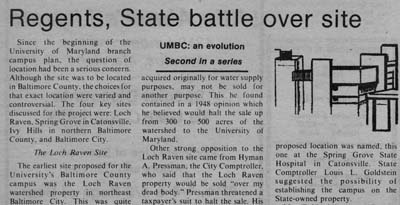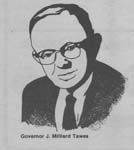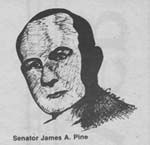Since the beginning of the University of Maryland branch campus plan, the question of location had been a serious concern. Although the site was to be located in Baltimore County, the choices for that exact location were varied and controversial. The four key sites discussed for the project were: Loch Raven, Spring Grove in Catonsville, Ivy Hills in northern Baltimore County, and Baltimore City.
The earliest site proposed for the University's Baltimore County campus was the Loch Raven watershed property in northeast Baltimore City. This was quite obviously a preferred site for the campus, but it was met with incredible opposition.
Before the sale of the property could be made to the University of Maryland, City Solicitor Joseph Allen stated that the sale "may be illegal." In an article, Allen said a formal opinion of one of his predecessors fifteen years ago, indicated that the watershed land acquired originally for water supply purposes, may not be sold for another purpose. This he found contained in a 1948 opinion which he believed would halt the sale up from 300 to 500 acres of the watershed to the University of Maryland.
Other strong opposition to the Loch Raven site came from Hyman A. Pressman, the City Comptroller, who said that the Loch Raven property would be sold "over my dead body." Pressman threatened a taxpayer's suit to halt the sale. His opposition was based on the legal requirement of the Baltimore City Charter that stated that the city may sell its land only if "no longer needed for public use." This strong opposition spelled the end of the University's plans to use the Loch Raven area.

The Spring Grove Site
In early September 1963 another proposed location was named, this one at the Spring Grove State Hospital in Catonsville. State Comptroller Louis L. Goldstein suggested the possibility of establishing the campus on the State-owned property.
Mr. Goldstein's appeal for the Catonsville site was based on the idea that the University should be located on State-owned land, if possible, to avoid the cost of buying private property. The hospital was established on 630 acres, and the campus would be built on 425 acres that was farmland at that time.
Although the Catonsville site offered many advantages, the University's central administration, and especially University of Maryland President Wilson Elkins, were not overjoyed with that proposed site. Elkins stated that the Spring Grove site "would be considered as a possible site, but that it did not appear to be an ideal location from our point of view." Elkins also stated that, "the University preferred a campus in the northern part of the county, not so close as Spring Grove to the main campus at College Park.
At the time, the Catonsville campus was not given primary consideration, however, it ultimately became the site for the University's second campus. Before this decision was made, a heated battle would ensue, causing deep scars between the University and Baltimore City's Mayor Theodore McKeldin. The main site that was being eyed by University officials was located in Baltimore County, north of the city in Ivy Hills, Maryland.
The Ivy Hills Site
After inspecting nearly 20 sites in northern Baltimore County, particular interest was being paid to a site in Ivy Hills, Maryland. University President Wilson Elkins said that the site met the board's criterion for selection, namely, "the site is accessible to both Baltimore City and surrounding counties over the Metropolitan area expressway system."
Another supporter of the Ivy Hills site was the County Executive Spiro T. Agnew, who urged planners to build the campus in that area.
The exact location of the "Ivy Hills" site is the neighborhood west of the Harrisburg Expressway, and west of Cockeysville between Shawan and Padonia Roads. The land, which was in "low-intensity" use at the time, was seen to be easily accessible, since it was composed of forest, farmland, and scattered housing. The holdings were large, but they would facilitate land purchases. Elkins said initially about 100 acres would be purchased with possible expansion to 500 acres in the future.
A major criticism of the site, however, was that its proximity to Towson State College might cause problems of competition. County officials rejected this contention, "The two institutions should complement each other, rather than compete."
Governor Millard J. Tawes and his colleagues on the Board of Public Works called Ivy Hills the "preferred possible" site, but stated that no site had been officially decided upon. The momentum for this northerly site was strong and all seemed a matter of routine, until another alternative site was proposed.
The Baltimore City Proposal

Of all the locations proposed for the Baltimore County campus of the University, the most controversial was a plan to place the University in the downtown area of Baltimore City.
Baltimore's Mayor McKeldin wrote a letter to Governor Tawes on September 4, 1963, urging that the proposed new campus be established in Baltimore to the west of the Inner Harbor. In his letter to the Governor, Mayor McKeldin suggested a campus bounded by the Inner Harbor on the east, Charles Center on the north, Camden Station on the west and the proposed East-West Expressway on the south.
Dr. Elkins, however, stated that the University officials were not interested in having the new campus in the city. Elkins said the Board of Regents and school officials studied the problem for several years before deciding that the northern part of the county would be best.
He said the planners opposed a "skyscraper university." County land would be cheaper, more accessible, and would permit easier expansion, he explained. On the other hand, several expensive city blocks would have to be cleared for a downtown campus.
At this point, the Sunpapers revived its editorial attack against the University's planning of its campus site. Commenting on McKeldin's Baltimore City plan, the Sun editorial stated:
"Governor Tawes said a few days ago that the question of selecting a site is now closed, although he did not go quite so far as to say it should be turned over to the Council.
All we need here apparently is a little push in the interest of fairness. The ardent supporters of a Baltimore County site could provide that push by joining with the Mayor, Senator James, and the others for an Advisory Council hearing. With unanamity of opinion, the Governor would go along.
A hearing would not clinch the case for or against a Baltimore City location. The Advisory Council might, after hearing both sides, say that the branch should be either place. At least, we would have avoided making this major Maryland decision before the Advisory Council, set up to guide the decision, could even organize."
As this passage indicates, the Sunpapers supported an investigation or at least a review, by the Advisory Council before the Governor decided on a site for the new campus. Here again is a strong indication that many people did not want the University of Maryland to have a carte blanche in making the major decisions on such a major project.
This criticism of Maryland's swift search was not the only one. On September 6, 1963, Dr. Earle T. Hawkins asked for a temporary halt to the University of Maryland site search. Hawkins was then President of Towson State University. Again, this criticism centered around an appeal to give the problem to the Advisory Council on Higher Education. "It might well be that a university branch is needed in Baltimore County, but no decision should be made until the Council has had time to study the matter," commented Hawkins. Dr. Hawkins further pointed out, "With six public institutions already located in the Baltimore area, any proposal to establish another, ought to be the subject of a good bit of study.
For this reason, Hawkins recommended that the board examine the problem first, especially since its membership represented other affected vital interests in the area. The board was composed of three members of the University of Maryland Board of Regents: three from the State Board of Education, two representing private colleges, and four from the public at large. Dr. Hawkins was himself a member of the Advisory Board.
On the 10th of September 1963, a major delay came to the University of Maryland plan. Senator William S. James (D. Harford County), and Delegate Marvin Mandel (D. Baltimore, 5th District) urged a delay in the decision.
"In a letter to Governor Tawes last Friday, Mr. James, President of the State Senate, expressed concern over the 'pellmell rush' of the University officials to serve a county site," Sun article reported.
"On the same day, Mr. Mandel, Acting Speaker of the House of Delegates, said the General Assembly did not expect the University to act this year in selecting a location," the article continued.

However, Senator James A. Pine accused Mandel and James of not keeping a breast of the legislature's intentions for construction of a county campus. Pine also informed Mayor McKeldin that a bill to put the campus in Baltimore City had been introduced and had failed during the same time that his Baltimore County bill had passed. Commenting on this new move by Mandel and James Pine responded, "The legislature has spoken passing the bill and the Governor has spoken by signing it. What else is needed?"
In spite of the pleas of Pine and Elkins, supporters of the Advisory Council got their wish. On October I, 1963, the Advisory Council for Higher Education met with the proposal for a campus location before them. The outcome, however, was not favorable to the rigorous supporters of the Council. For them, the disappointment came when the Council could not decide whether they should take up the question of the University of Maryland's proposed branch campus.
The next day, a Sunpapers editorial criticizing the "no decision" decision was printed; it was entitled "Dismal Outlook" and reeked of disappointment from the lack of action the Advisory Council endorsed. The following is the reprint of that October 2 editorial.
The new Advisory Council for Higher Education could not decide whether it should take up the question of a branch campus of the University of Maryland Baltimore County without first talking to Governor Tawes. So the Council's Chairman has sought out Mr. Tawes and has emerged with no decision.
Meanwhile, the University is moving fast on selection of a county site. By the time the Advisory Council meets again, (its sessions occur about as frequently as total eclipses) the University Board of Regents are expected to have met and agreed on a site to be selected by a committee this week.
Thus, the stage is set for two propositions to go to Annapolis in search of construction funds. One is the previously adapted state plan to expand the teachers colleges into general institutions of higher learning. That plan will call for a heavy construction appropriation to enlarge Towson State College to meet college demands in the Baltimore Metropolitan area. At the same time, as the situation now shapes up, there will be a call for funds to build, a few miles from the Towson College to serve the undergraduate needs of the Metropolitan area.
What will happen when the two plans hit Annapolis? Judging by the past, it is unlikely the Tawes Administration and the General Assembly will have the courage to say "no" to one institution or the others. What is all too probable is a compromise cutting back on both plans and leaving the Metropolitan area with the prospect of two mediocre institutions of higher learning.
This editorial shows great dissatisfaction with the board's decision not to act. The Sunpapers, who had actively supported the proposal for the Advisory Board to study the problem lost a critical battle when the Board decided to abstain. This marked the end of the most serious prospect to halt the University of Maryland's fast pace planning of its Baltimore County campus. The University and Senator Pine had avoided interference of their plans for the new campus by the Advisory Council.
Continue to part three, "Urban campus site shunned"
Return to the series homepage